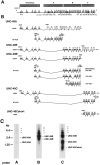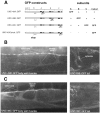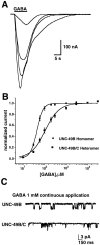The Caenorhabditis elegans unc-49 locus encodes multiple subunits of a heteromultimeric GABA receptor
- PMID: 10377345
- PMCID: PMC6782323
- DOI: 10.1523/JNEUROSCI.19-13-05348.1999
The Caenorhabditis elegans unc-49 locus encodes multiple subunits of a heteromultimeric GABA receptor
Abstract
Ionotropic GABA receptors generally require the products of three subunit genes. By contrast, the GABA receptor needed for locomotion in Caenorhabditis elegans requires only the unc-49 gene. We cloned unc-49 and demonstrated that it possesses an unusual overlapping gene structure. unc-49 contains a single copy of a GABA receptor N terminus, followed by three tandem copies of a GABA receptor C terminus. Using a single promoter, unc-49 generates three distinct GABAA receptor-like subunits by splicing the N terminus to each of the three C-terminal repeats. This organization suggests that the three UNC-49 subunits (UNC-49A, UNC-49B, and UNC-49C) are coordinately rescued and therefore might coassemble to form a heteromultimeric GABA receptor. Surprisingly, only UNC-49B and UNC-49C are expressed at high levels, whereas UNC-49A expression is barely detectable. Green fluorescent protein-tagged UNC-49B and UNC-49C subunits are coexpressed in muscle cells and are colocalized to synaptic regions. UNC-49B and UNC-49C also coassemble efficiently in Xenopus oocytes and HEK-293 cells to form a heteromeric GABA receptor. Together these data argue that UNC-49B and UNC-49C coassemble at the C. elegans neuromuscular junction. Thus, C. elegans is able to encode a heteromeric GABA receptor with a single locus.
Figures






Similar articles
-
Pharmacological characterization of the homomeric and heteromeric UNC-49 GABA receptors in C. elegans.Br J Pharmacol. 2003 Mar;138(5):883-93. doi: 10.1038/sj.bjp.0705119. Br J Pharmacol. 2003. PMID: 12642390 Free PMC article.
-
The composition of the GABA receptor at the Caenorhabditis elegans neuromuscular junction.Br J Pharmacol. 2005 Feb;144(4):502-9. doi: 10.1038/sj.bjp.0706052. Br J Pharmacol. 2005. PMID: 15655525 Free PMC article.
-
An UNC-49 GABA receptor subunit from the parasitic nematode Haemonchus contortus is associated with enhanced GABA sensitivity in nematode heteromeric channels.J Neurochem. 2010 Jun;113(5):1113-22. doi: 10.1111/j.1471-4159.2010.06651.x. Epub 2010 Feb 23. J Neurochem. 2010. PMID: 20180830
-
UNC-52/perlecan isoform diversity and function in Caenorhabditis elegans.Biochem Soc Trans. 2001 May;29(Pt 2):171-6. doi: 10.1042/0300-5127:0290171. Biochem Soc Trans. 2001. PMID: 11356148 Review.
-
Ionotropic GABA and Glutamate Receptor Mutations and Human Neurologic Diseases.Mol Pharmacol. 2015 Jul;88(1):203-17. doi: 10.1124/mol.115.097998. Epub 2015 Apr 22. Mol Pharmacol. 2015. PMID: 25904555 Free PMC article. Review.
Cited by
-
An extrasynaptic GABAergic signal modulates a pattern of forward movement in Caenorhabditis elegans.Elife. 2016 May 3;5:e14197. doi: 10.7554/eLife.14197. Elife. 2016. PMID: 27138642 Free PMC article.
-
Pharmacological characterization of the homomeric and heteromeric UNC-49 GABA receptors in C. elegans.Br J Pharmacol. 2003 Mar;138(5):883-93. doi: 10.1038/sj.bjp.0705119. Br J Pharmacol. 2003. PMID: 12642390 Free PMC article.
-
PRMT1 Deficiency in Mouse Juvenile Heart Induces Dilated Cardiomyopathy and Reveals Cryptic Alternative Splicing Products.iScience. 2018 Oct 26;8:200-213. doi: 10.1016/j.isci.2018.09.023. Epub 2018 Oct 2. iScience. 2018. PMID: 30321814 Free PMC article.
-
Deep conservation of genes required for both Drosphila melanogaster and Caenorhabditis elegans sleep includes a role for dopaminergic signaling.Sleep. 2014 Sep 1;37(9):1439-51. doi: 10.5665/sleep.3990. Sleep. 2014. PMID: 25142568 Free PMC article.
-
Presynaptic terminals independently regulate synaptic clustering and autophagy of GABAA receptors in Caenorhabditis elegans.J Neurosci. 2006 Feb 8;26(6):1711-20. doi: 10.1523/JNEUROSCI.2279-05.2006. J Neurosci. 2006. PMID: 16467519 Free PMC article.
References
-
- Alfonso A, Grundahl K, McManus JR, Asbury JM, Rand JB. Alternative splicing leads to two cholinergic proteins in Caenorhabditis elegans. J Mol Biol. 1994;241:627–630. - PubMed
-
- Amin J, Weiss DS. Homomeric ρ1 GABA channels: activation properties and domains. Receptors Channels. 1994;2:227–236. - PubMed
-
- Amin J, Weiss DS. GABAA receptor needs two homologous domains of the beta-subunit for activation by GABA but not by pentobarbital. Nature. 1993;366:565–569. - PubMed
-
- Andres AJ, Thummel CS. Methods for quantitative analysis of transcription in larvae and prepupae. Methods Cell Biol. 1994;44:565–573. - PubMed
-
- Ausubel FM, Brent R, Kingston RE, Moore DD, Seidman JG, Smith JA, Struhl K. Current protocols in molecular biology. Wiley; New York: 1995.
Publication types
MeSH terms
Substances
Associated data
- Actions
- Actions
- Actions
- Actions
- Actions
- Actions
Grants and funding
LinkOut - more resources
Full Text Sources
Other Literature Sources
Molecular Biology Databases
Miscellaneous
